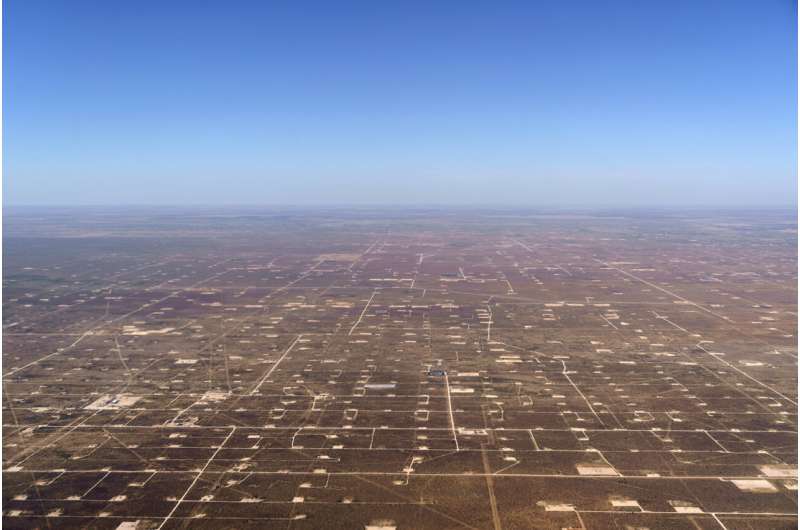On Monday, October 11, 2021, patches of oil pump jackets can be found in the landscape of the Permian Basin in Midland, Texas. Carbon Mapper, a collaboration of university researchers and NASA’s Jet Propulsion Laboratory, documented massive amounts of methane flowing into the atmosphere from oil and gas operations across the Permian, a bone-dry 250-mile-wide plain along the Texas-New Mexico border that lasted a billion years. ago was the bottom of a shallow sea. Credit: AP Photo/David Goldman
The Environmental Protection Agency says it will conduct helicopter flights to search for methane “super-radiators” in the country’s largest oil and gas-producing region.
EPA’s Region 6 headquarters in Dallas, Texas, has a press release on a new enforcement effort in the Perm basin on Monday, saying the flights would take place within the next two weeks.
The announcement came four days after The Associated Press published an investigation that found 533 oil and gas facilities in the region were emitting excessive amounts of methane, citing the companies most responsible. Colorless and odorless, methane is a potent greenhouse gas that traps 83 times more heat in the atmosphere than an equivalent amount of carbon dioxide over a 20-year period.
EPA spokesman Tim Carroll said the timing of the agency’s announcement was unrelated to the AP’s story and that similar overflights had been conducted in recent years. EPA officials made no mention of an upcoming enforcement action in the Permian when interviewed by the AP last month.
EPA Region 6 administrator Earthea Nance said the Permian Basin accounts for 40 percent of our country’s oil supply and has been releasing dangerous amounts of methane and volatile organic compounds for years, contributing to climate change and poor air quality.
A flare burns methane and other hydrocarbons as oil pump jackets operate in the Permian Basin in Midland, Texas, Tuesday, Oct. 12, 2021. Massive amounts of methane escape into the atmosphere from oil and gas operations in the Permian Basin, new aerial studies show . The emissions jeopardize U.S. targets for climate change mitigation. Credit: AP Photo/David Goldman
“The flyovers are vital to identify which facilities are responsible for the bulk of these emissions and therefore where reductions are most urgently needed,” Nance said, according to the agency’s press release.
AP used 2021 data from the group Carbon Mapper to document massive amounts of methane escaping into the atmosphere from oil and gas operations across the Permian, a 250-mile-wide bone-dry plain along the Texas-New Mexico border that was the bottom of a shallow sea a billion years ago.
Carbon Mapper, a collaboration of NASA’s Jet Propulsion Laboratory and academic researchers, used an aircraft with a infrared spectrometer to detect and quantify the unique chemical fingerprint of methane in the atmosphere. Hundreds of locations were shown spewing the gas continuously over multiple overflights.
Last October, AP journalists, using a FLIR infrared camera, visited more than two dozen sites identified by Carbon Mapper as persistent methane super emitters and recorded large plumes of hydrocarbon gas containing methane escaping from pipeline compressors, tank batteries, flares and other production infrastructure. The Carbon Mapper data and camera work from the AP show that many of the worst polluters are steadily charging Earth’s atmosphere with this extra gas.
Carbon Mapper identified the spitting sites only by their GPS coordinates. The AP then took the coordinates of the 533 “super-emitting” sites and referenced them with state drilling permits, air quality permits, pipeline maps, land records and other public documents to aggregate the companies likely responsible.
Flares burn methane and other hydrocarbons at an oil and gas plant in Lenorah, Texas, Friday, Oct. 15, 2021. Huge amounts of methane escape into the atmosphere from oil and gas operations in the Permian Basin, new aerial surveys show. The emissions jeopardize U.S. targets for climate change mitigation. Credit: AP Photo/David Goldman
Only 10 companies owned at least 164 of those sites, according to an AP analysis of Carbon Mapper’s data.
The AP also compared the estimated rates at which the superemissive sites are flowing methane with the annual reports the companies are required to file with EPA detailing their greenhouse gas emissions. AP found that the EPA’s database often does not take into account the actual rate of emissions observed in the Permian.
The methane released by these companies will disrupt the climate for decades and contribute to more heat waves, hurricanes, wildfires and floods. There is now almost three times as much methane in the air as before industrial times. The year 2021 saw the worst single increase ever.
EPA recently introduced restrictions on the amount of methane released from new oil and gas facilities. But proposed regulations for the hundreds of thousands of older sites responsible for most of the emissions are still under review. What is restricted under current federal regulations are toxic air pollutants such as hydrogen sulfide, sulfur dioxide and carcinogenic benzene that often accompany methane and are sometimes referred to as “ride-on” gases.
EPA said this week it would also collect data from its aerial observations in the Permian and use the GPS locations to identify the facilities releasing excess emissions. The agency said it will initiate enforcement actions against the responsible companies, including administrative enforcement actions and referrals to the Justice Department. EPA said companies found to be violating federal law could face significant financial penalties, as well as future monitoring to verify that corrective action has been taken.
Hidden Threat: Massive Methane Leaks Accelerate Climate Change
© 2022 The Associated Press. All rights reserved. This material may not be published, broadcast, rewritten or redistributed without permission.
Quote: EPA announces flights to search for methane in the Permian Basin (2022, Aug. 3), retrieved Aug. 3, 2022 from https://phys.org/news/2022-08-epa-flights-methane-permian- basin.html
This document is copyrighted. Other than fair dealing for personal study or research, nothing may be reproduced without written permission. The content is provided for informational purposes only.

